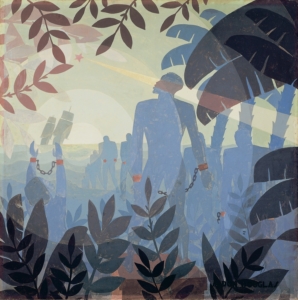Like other elements of Black culture, graphic design with African representation is not given its due visibility and recognition. This was especially the case in historical times as the notions and values of White supremacy formed the grounds for the articulation of all human interactions, intelligence, and expressions. Despite their great influence on Black-themed arts and the Black community, the profound achievements of these designers are, unfortunately, gravely understated.
In the highlight of February as Black History Month and in the spirit of commemorating influential key figures who made a mark on the world and Black community, here are seven prominent black graphic designers you probably did not know
Aaron Douglas
Adapted from: Aaron Douglas | Muddy Colors
Aaron Douglas, born May 26, 1899, regarded by many as the father of African-American Art. He was born to parents; Aaron Douglas Sr, a baker, and Elizabeth Douglas a homemaker and a layman artist. They lived in Topeka, Kansas, where Douglas would travel from to the University of Nebraska where he enrolled in Fine Arts. Douglas was academically erudite and artistically gifted, these were attributes outlined in a recommendation offered by his professor at the university from where he matriculated into the working world as a public school teacher.
Key highlights of his career:
Douglas was one of the leading artists in the New Negro Movement, also known as the Harlem Renaissance. This movement was spearheaded by Black radicals such as Web Du Bois and Marcus Garvey. The rendition of his work was very controversial and devoid of the European trajectory.
His valiance was substantiated once again when he along with Langston Hughes and others published a Black-centric magazine. This periodical focussed on racially charged issues such as sexuality within the Black community and interracial relationships.
Douglas was also known for his famous paintings which often took the form of murals. One of his exhibitions, known as the “Aspects of the Negro Life,” is a series of paintings that portray the four stages of African-American cultural shifts: The Negro in the African Setting, Song of the towers, From Slavery through Reconstruction, and An Idyll of the Deep South.
Leroy Winbush
Winbush was born on December 7, 1915, in Memphis, Tennessee. Following the separation of his parents, he moved with his father to Detroit and after to Chicago, when he turned fourteen to attend the Englewood High School. Winbush is versatile in many respects, not only is he known for his outstanding skills in graphic design but he was also an excellent scuba diver, bowler, and skier.
Winbush defied the odds of not having any formal training to be a graphic designer to becoming undeniably one of the best. Through this burning passion and desire, he was able to make a name for himself while he created an avenue and hope for many aspiring Black graphic designers, in pursuit of the field of practice predominantly occupied by the White male.
Key highlights of his career:
Aforementioned, Winbush had a very versatile character. Outside of visual art, he showed a keen interest in music. In the early part of his life, he participated in a singing trio called the Melody Mixers which garnered a lot of traction through their accomplished performances at hotels, clubs, CBS, and NBS newsroom.
In 1938 he was hired by the Regal Theatre to design and paint the theatre front. Hereafter he was fully commissioned to design signs and posters at the Goldblatt’s Department Store, where he worked as the only African American. Eventually, he was employed as an art director.
Other reputable positions held by Winbush include his place as the director of design for Illinois Sesquicentennial Celebration and assistant art professor at the School of Art Institue in Chicago. All this he accomplished without having ever stepped foot in a college lecture theatre or art school.
Charles Dawson

Adapted from: blackartauction.com | Charles Dawson, 1889-1981, Southern Scene …
Another worthy mention is Charles Dawson who was born in 1889. He was the son of a hardworking middle-class family in Brunswick Georgia. In 1907 he left for New York after being attended the Tuskegee Institute famed by Booker T. Washington. Hereafter he became the very first African American to be accepted into the Art Student League in the city. His admittance came with no overrides as he was taunted daily with many challenges and instances of racism and discrimination. To make matters worse he had to undertake unskilled and nonprofessional jobs, that paid very little, as a means to sustain themselves. Eventually, he gathered enough funds to pay his tuition and earn his place at the Art Institute of Chicago.
In the period of 1920s-1930s Dawson one of the most creative graphic designers within his area. During this period he worked as a commercial curator, which created an image brand of illustrated advertisements for beauty schools and products for Blacks. Some of these include Annie Marie Poro’s College, Valmore, and Murray products.
Key highlights of his career:
In 1934 he was the only Black man with a sizeable role in the Century of Progress Fair. His exhibition piece, a mural, was showcased by the National Urban League in the Hall of Social Science.
His Negro in Art Week exhibition was the first African American show to receive a substantial endorsement from and have his place set at an American museum.
Sylvia Harris
Sylvia Harris was born in 1953 in Richmond, Virginia. Her work revolving around the Black community was not limited to creating imagery for the values that stood behind it. Harris spent much of her professional life working directly and within Black communities. This included collaborating with the necessary political forces to ameliorate the social conditions within them and also being an arbitrary voice to the voiceless.
Her career as a designer started when she was first employed at the WGBH, a local television station in Boston. After this, she matriculated to The Architects Collaborative. In 1908, with the support of a few colleagues, she established a design consulting firm.
Key highlights in her career :
Sylvia’s work in graphic design includes the designing of postage stamps. This means anyone who sent or received a package from any Mailroom within America would have benefitted from these efforts.
She was the creative director for the 2000 United States Census Bureau. Through this role, she actively encouraged more Americans to participate, a noteworthy record from the mark from the previous census. Sylvia understood the importance of having the under-represented voices of a minority group, such as the Black community, heard.
She also worked on various state projects aligned with the New York State Council of Arts. One such assignment was done at the Central Park Zoo. The object, as she posited, was to create a beautiful place where people could go to relax. The graphical aesthetics at this particular site is one to behold.
Georg Olden
The Poster Boys – Title cards for CBS by Georg Olden
Olden was born on November 13, 1920, in Birmingham, Alabama. He was the son of an escaped slave and an opera singer. Like many of his Black graphic designers, Olden’s work was revolutionary and unconventional in comparison to the hegemonic standards of the arts. He was one of the few black professionals who became a part of an industry that proved to be forbidden grounds for men of his skin colour, far before it received any attention from the civil rights and other black movements.
Olden worked as a graphic designer for the Office of Strategic Services, also known as the organization which preceded the development of the Central Intelligence Agency (CIA). He also worked with leading writers, painters, and graphic designers whose titles afforded him countless opportunities before the war.
Key highlights of his career:
After the war in 1945, Olden was invited to work for CBS by the Vice President himself, Colonel Lawrence W. Lowman, who was also the head of the OSS communications division. At this time Olden was only 25 years old.
He designed a stamp commemorating the 100th anniversary of the Emancipation Proclamation. The simple but meaningful image of a broken chain was symbolic of the overarching theme of freedom. He was invited to the White House by J.F. Kennedy who extolled this marvelous craft.
Thirty-two years after his death and in 2007, he received a distinguished accolade, the AIGA medal-winning graphic designer who worked in advertising and television.
Michael Thompson
Michael Thompson “Freestylee”, I Am Tivoli Jamaica in 2019 …
Michael Thompson, also known as ‘Freestyle’ was born in 1958 in Kingston, Jamaica. He lived in Easton, Pennsylvania for more than 25 years. In 1980 he studied graphic design at the Jamaican School of Art. One of his biggest mentors, Daniel Hartman, influenced him through the output of his drawings. Hartman’s pieces captured Rastafari as a liberation movement, a resistance to the then apartheid movement that was taking place in South Africa.
Key highlights of his career
In the 1970s to 1980s, he won two successive poster competitions in Jamaica which allowed him to participate with the Jamaican delegation in the 11th World Festival of Youth and Students in Havanna, Cuba in 1978, and again in Moscow in 1985.
He inspired many progressive artists, like his son Dane Thompson, co-founder of Maria Papaefstathiou.
Michael designed more than 500 posters during the last seven years of his life.
Ainsworth David Scott, O.D.
A.D. Scott, also known as ‘Scotty’ was born on January 27, 1912, in Jamaica. He attended Kingston College when it was first established in 1925. After his high school life, he left Jamaica for Canada where he earned a Bachelor’s degree in Civil Engineering at McGill University in Montreal. Following his return to Jamaica, he was assigned the role of engineer to oversee the construction of the then, University College of the West Indies.
Outside of his passions as an engineer, Scott had a passion for visual arts. He strongly held on the idea that art was a progressive path to the development of culture. Additionally, he also entertained the idea of integrating arts within the prospects of the business. Scott also served as the Chairman of the Contemporary Jamaican Artists Association from the 1960s to the 1970s. He possessed one of the largest art collections with pieces from all over the traditional and contemporary world.
Key highlights of his career
He is a recipient of many national honours including a Silver Musgrave medal (1878) and Order of Distinction (1975).
Scott was a key pioneer in the formalization of the Nation Gallery of Jamaica where he served as a board director while donating pieces from his own personal collection as an altruistic gesture.


